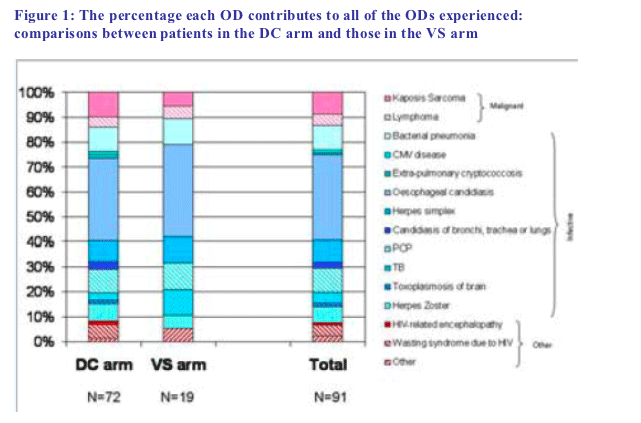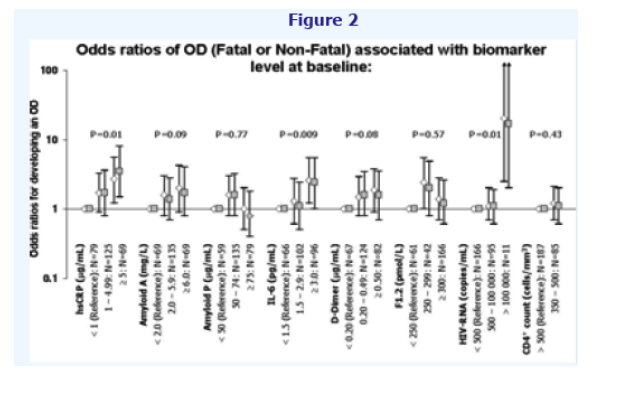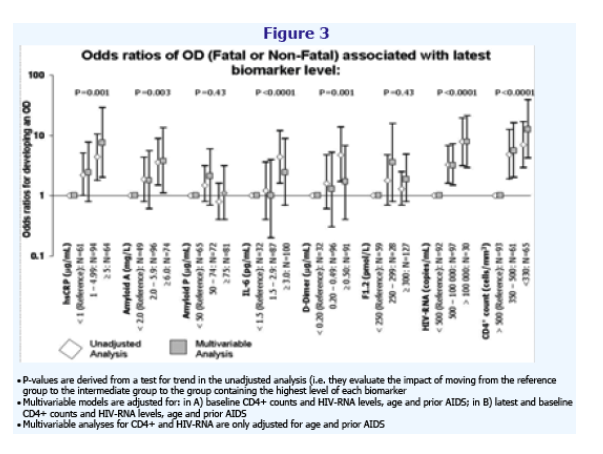 |
 |
 |
| |
Activation (Inflammation) and Coagulation Biomarkers are Independent Predictors for the Development of Opportunistic Disease in Patients with HIV Infection
|
| |
| |
Reported by Jules Levin
CROI 2009 Montreal Feb 8-12
Alison J Rodger1, Zoe Fox1,2, Jens D Lundgren2, Lew Kuller3, Christoph Boesecke4, Daniela Gey2 , Athanassios Skoutelis5, Matthew Bidwell Goetz6 and Andrew N Phillips1 for the INSIGHT SMART Study Group
1University College London, London, UK, 2Rigshospitalet and University of Copenhagen, Copenhagen, Denmark, 3University of Pittsburgh, Pittsburgh, USA, 4National Centre in HIV Epidemiology and Clinical Research, Sydney, Australia, 5Evangelismos, General Hospital, Athens, Greece , 6VA Greater Los Angeles Healthcare System, Los Angeles, USA
AUTHOR CONCLUSIONS
We found that both baseline and latest levels of IL-6 and hsCRP were independently associated with developing an OD, with a significant trend towards increased risk of OD with higher levels of the biomarkers at both baseline and prior to the event. Although reverse causality may have influenced this association, the fact that baseline levels also predicted OD events makes it less likely.
The odds of developing an OD were 3.8 times greater for those randomised to the DC arm compared to those randomised to the VS arm
The strongest predictors in our study for development of OD remained a previous AIDS defining diagnosis and latest CD4+ count and latest HIV-RNA levels, however use of biomarkers could provide additional prognostic information for predicting risk of development of OD.
An interesting aspect of this analysis was that D-dimer the most predictive biomarker of mortality in SMART was not significantly associated with OD, likely reflecting the contribution of cardiovascular disease to overall mortality. [2]
The limited panel of biomarkers studied restricted our study as other pro- inflammatory cytokines released during the immune activation observed in uncontrolled HIV disease may also have prognostic value for risk of development of opportunistic disease
INTRODUCTION
The SMART trial (Strategies for Management of Antiretroviral Therapy) examined the effects of intermittent antiretroviral (ARV) therapy in HIV-positive patients compared to continuous ARVs. In the main analysis, those randomised to the intermittent arm had a 2.6-fold (95% confidence interval [CI]: 1.9 to 3.7) increased hazard of opportunistic disease (OD) or death compared to those in the continuous arm. [1]
Persistent activation of inflammatory markers appears to have long term pathological consequences for patients, has been implicated in the pathogenesis of atherosclerotic disease and is an independent risk factor for death in other immuno-suppressed patient groups such as those with end stage renal failure. Observational studies have demonstrated that HIV-infected patients have higher levels of inflammatory markers compared to non HIV- infected patients and that inflammatory markers increase in advanced HIV disease and are predictive of poorer outcome.
Using a nested case-control study within the SMART trial we examined associations between markers of inflammation and the development of an OD, both in patients taking ARVs and in those for whom therapy was interrupted. We hypothesised that elevations in levels of biomarkers could be used to identify patients at particular risk of development of an OD in the clinical setting.
METHODS
Patients (n=5472) were randomised to one of two ARV treatment arms; the viral suppression (VS) arm involved continuous use of ARVs or the drug conservation arm (DC) involved CD4+ guided interruptions to therapy. The primary endpoint in SMART was the development of new or recurrent opportunistic disease or death. Enrolment was discontinued in January 2006 because of an observed increased risk of OD and death in the DC arm compared to the VS arm.
Overall, 5161 of 5472 (94.3%) patients gave informed consent to have plasma stored at baseline and at every follow up visit thereafter. The following biomarkers, which all have high laboratory reproducibility, were measured hsCRP, amyloid A, amyloid P, IL-6, D-dimer and prothrombin fragment 1+2.
Baseline and follow up samples were identified for 273 patients: 91 patients who developed an OD and two matched controls for case. Follow up samples (i.e. latest levels) were selected from the visit before the OD for cases and at the same time-point for the matched controls.
Patients were separated into three groups according to their biomarker level, categorised according to clinically relevant cut-offs or split according to the nearest round value of the biomarker to the tertile.
Baseline characteristics were compared between cases and controls using conditional logistic regression analysis for matched case-control studies. Conditional logistic regression analyses was used to assess the associations between both baseline and latest levels of each biomarker with OD.
RESULTS
There were 91 cases of OD during SMART: infective (n= 72, 79%), malignant (n=12, 13%) and other (n=7, 8%). Figure 1

The odds of developing an OD were 3.8 times greater for those randomised to the DC arm compared to those randomised to the VS arm (95% CI: 2.1 to 6.9, P<0.0001). Having a previous AIDS defining diagnosis was significantly associated with subsequent development of OD (Odds ratio (OR): 3.1, 95% CI: 1.6 to 5.9, P<0.0001) as was age at baseline (OR: 1.7, 95% CI: 1.0 to 2.9 for every five years older, P=0.04).
In Figure 2 patients were grouped according to baseline levels of each biomarker, and after adjustment both IL-6 and CRP demonstrated a significant trend towards an increased risk of OD with increasing biomarker levels at baseline. Patients with hsCRP levels >/=5 ug/mL had 3.5 (95% CI: 1.5 to 8.1) higher odds of an OD compared to those with CRP levels <1 ug/ml, Ptrend=0.003, and patients with IL-6 >/=3 pg/mL had 2.4 (95% CI: 1.0 to 5.4) higher odds of an OD compared to those with an IL-6 <1.5 pg/mL, Ptrend=0.02. No other baseline biomarkers were predictive of development of an OD.
The median time between the measurement of the latest biomarker and the OD was 73 days (IQR: 39 to 126 days) for cases and 90 days (IQR: 33 to 161 days) for controls. After adjustment for baseline factors and the latest CD4 counts and HIV-RNA levels, the latest hsCRP (OR 7.6 (95% CI: 2.0 to 28.5) for those with hsCRP >/=5 ug/mL versus those with hsCRP <1 ug/ml, Ptrend=0.002) and the latest IL-6 (OR 2.4 (95% CI: 0.7 to 8.8) for patients with IL-6 >/=3 pg/mL versus those with IL-6 <1.5 pg/mL, Ptrend=0.04) were independently associated with development of an OD. (Figure 3)
There were no interactions between treatment arm and baseline and latest biomarker levels and the development of an OD.


|
| |
|
 |
 |
|
|